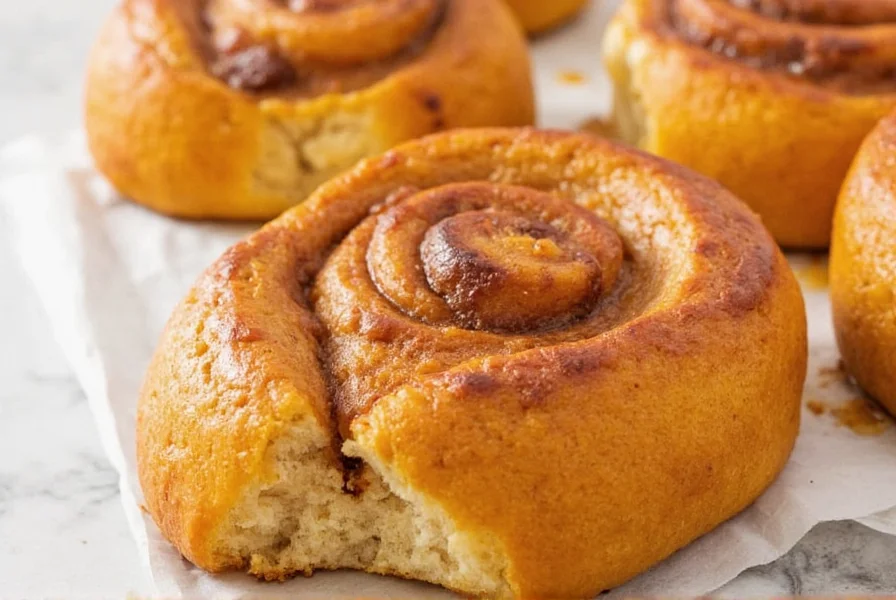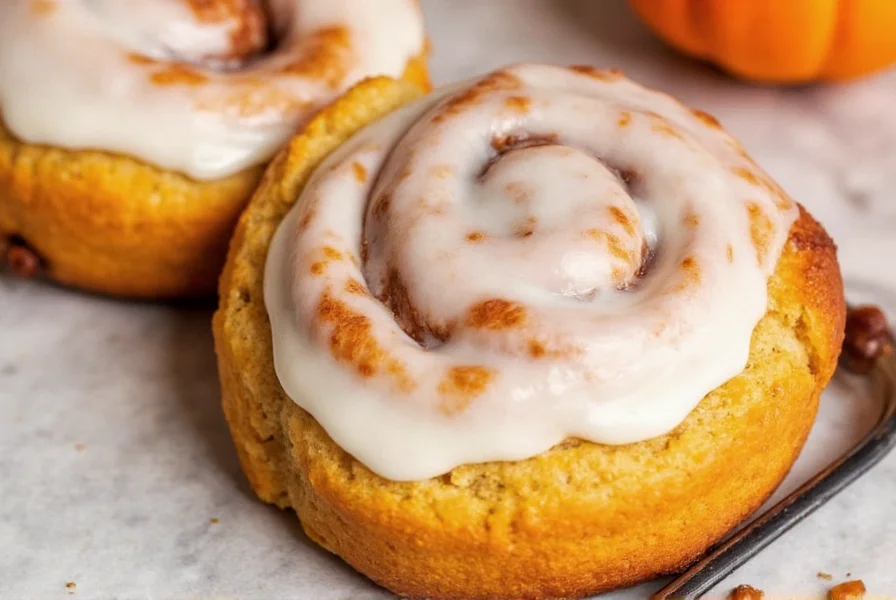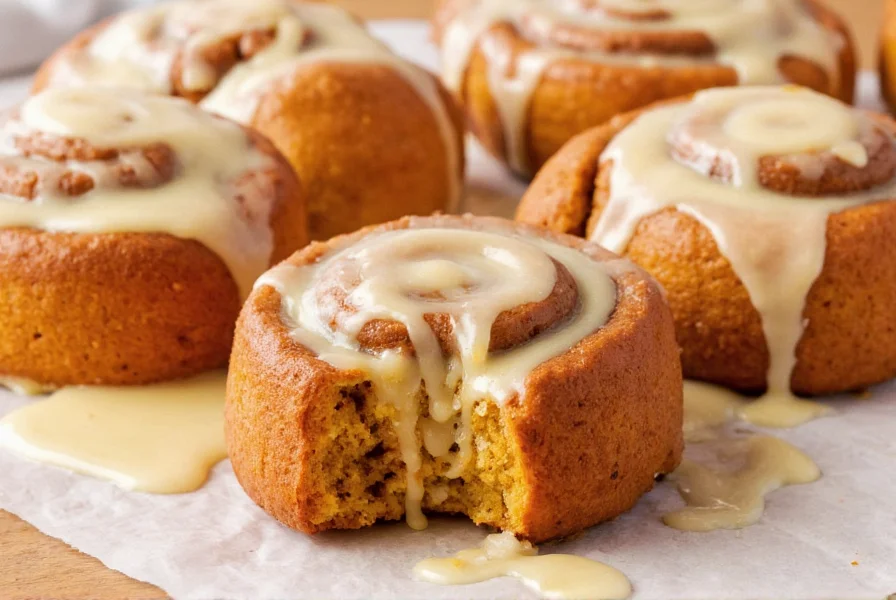The Ultimate Guide to Perfect Pumpkin Cinnamon Buns
Nothing says autumn quite like the aroma of freshly baked pumpkin cinnamon buns wafting through your kitchen. These delectable pastries have evolved from simple cinnamon rolls to a sophisticated seasonal specialty that balances pumpkin's natural sweetness with warming spices. Unlike basic cinnamon rolls, pumpkin cinnamon buns incorporate pure pumpkin puree directly into the dough, creating a richer flavor profile and distinctive orange hue.
Why Pumpkin Cinnamon Buns Stand Out
What makes pumpkin cinnamon buns special compared to traditional cinnamon rolls? The addition of pumpkin puree transforms both texture and taste. Pumpkin adds moisture that keeps buns soft for days, creates a tender crumb structure, and provides a subtle earthy sweetness that complements rather than overpowers the cinnamon filling. Professional bakers note that the natural sugars in pumpkin caramelize beautifully during baking, creating complex flavor notes that simple cinnamon rolls lack.
| Ingredient | Traditional Cinnamon Roll | Pumpkin Cinnamon Bun |
|---|---|---|
| Dough Base | Plain yeast dough | Pumpkin-enriched dough |
| Moisture Content | Moderate | Higher (from pumpkin) |
| Flavor Profile | Sweet, buttery | Earthy, spiced, complex |
| Shelf Life | 1-2 days | 3-4 days |
Essential Ingredients for Success
The magic of perfect pumpkin cinnamon buns happens through careful ingredient selection. For best results when making homemade pumpkin cinnamon buns, use these professional recommendations:
- Pumpkin puree: Always use 100% pure pumpkin, not pumpkin pie filling which contains added sugars and spices
- Yeast: Fresh active dry yeast produces superior rise compared to instant yeast for this application
- Cinnamon: Ceylon cinnamon offers a more delicate flavor that won't overpower the pumpkin
- Cream cheese: Full-fat brick-style cream cheese creates the ideal frosting texture

Step-by-Step Baking Process
Creating bakery-quality pumpkin cinnamon buns at home requires attention to detail at each stage. Follow these steps for consistent results:
- Dough preparation: Warm milk to 110°F (43°C), then combine with yeast and sugar. Let sit for 5-7 minutes until foamy. Mix pumpkin puree with softened butter, eggs, and dry ingredients before incorporating the yeast mixture.
- Kneading technique: Knead dough for 8-10 minutes until smooth and elastic. Pumpkin adds moisture, so resist adding excess flour during this stage. The dough should be slightly tacky but not sticky.
- Rising process: Let dough rise in a greased bowl covered with plastic wrap in a warm spot (75-80°F/24-27°C) for 1-1.5 hours, or until doubled in size. Cooler temperatures extend rising time but develop better flavor.
- Filling application: Roll dough into a 16x12 inch rectangle. Spread softened butter evenly, then sprinkle cinnamon-sugar mixture (1 cup brown sugar + 3 tbsp cinnamon + 1 tsp pumpkin pie spice).
- Rolling and cutting: Roll tightly from the long side, pinch seam to seal, then cut into 12 equal pieces using dental floss for clean slices without squishing.
- Baking temperature: Bake at 350°F (175°C) for 22-25 minutes until golden brown. Overbaking dries out the delicate pumpkin-enriched dough.
Avoiding Common Baking Mistakes
Even experienced bakers encounter challenges with pumpkin cinnamon buns. These troubleshooting tips address frequent issues:
- Dense texture: Usually caused by over-flouring the dough. Measure flour properly using the spoon-and-level method, not scooping directly from the bag.
- Filling leakage: Prevent this by leaving a ½ inch border when spreading filling and ensuring a tight roll with sealed seams.
- Soggy bottoms: Place baking pan on a preheated baking sheet to ensure even heat distribution from below.
- Flat rolls: Over-rising causes rolls to spread instead of rising. Monitor dough carefully during the second rise (20-30 minutes).

Storage and Serving Recommendations
Pumpkin cinnamon buns maintain their exceptional texture longer than traditional rolls thanks to the pumpkin's natural moisture. For optimal freshness:
- Cool completely before storing to prevent condensation
- Store in an airtight container at room temperature for 3-4 days
- Reheat individual buns for 15 seconds in the microwave before serving
- Freeze unfrosted buns for up to 3 months; thaw and frost before serving
For the best eating experience, serve pumpkin cinnamon buns slightly warm. The heat enhances the aromatic compounds in both the pumpkin and spices, creating a more complex flavor profile. Pair with strong coffee or chai tea to complement the warm spices.
Variations for Dietary Preferences
Adapt this classic recipe to accommodate various dietary needs without sacrificing flavor:
- Gluten-free: Substitute 1:1 gluten-free flour blend and add 1 tsp xanthan gum
- Dairy-free: Use coconut oil instead of butter and vegan cream cheese for frosting
- Lower sugar: Reduce filling sugar by 25% and use monk fruit sweetener in frosting
- Nut-free: Ensure all ingredients are processed in nut-free facilities
Frequently Asked Questions
Can I use canned pumpkin pie filling instead of pure pumpkin?
No, pumpkin pie filling contains added sugars and spices that will throw off your recipe's balance. Always use 100% pure pumpkin puree for best results when making pumpkin cinnamon buns from scratch.
How do I prevent my pumpkin cinnamon buns from becoming too dense?
Measure flour properly using the spoon-and-level method, not by scooping. Pumpkin adds significant moisture, so resist adding extra flour during kneading. The dough should be slightly tacky but not sticky. Over-kneading can also develop too much gluten, leading to dense buns.
What's the ideal temperature for baking pumpkin cinnamon buns?
Bake at 350°F (175°C) for 22-25 minutes. This temperature allows the pumpkin-enriched dough to cook through without drying out. Use an instant-read thermometer to check internal temperature - it should register 190°F (88°C) when properly baked.
Can I prepare pumpkin cinnamon buns ahead of time?
Yes, you can assemble the rolls, place them in the pan, cover, and refrigerate overnight. Let them sit at room temperature for 30 minutes before baking. The cold fermentation actually enhances flavor development while providing morning convenience.
Why do my pumpkin cinnamon buns spread too much during baking?
Excessive spreading usually indicates over-rising during the second proof. Pumpkin dough should only rise until nearly doubled (about 20-30 minutes). Over-rising weakens the gluten structure, causing rolls to spread instead of rising upward during baking.











 浙公网安备
33010002000092号
浙公网安备
33010002000092号 浙B2-20120091-4
浙B2-20120091-4